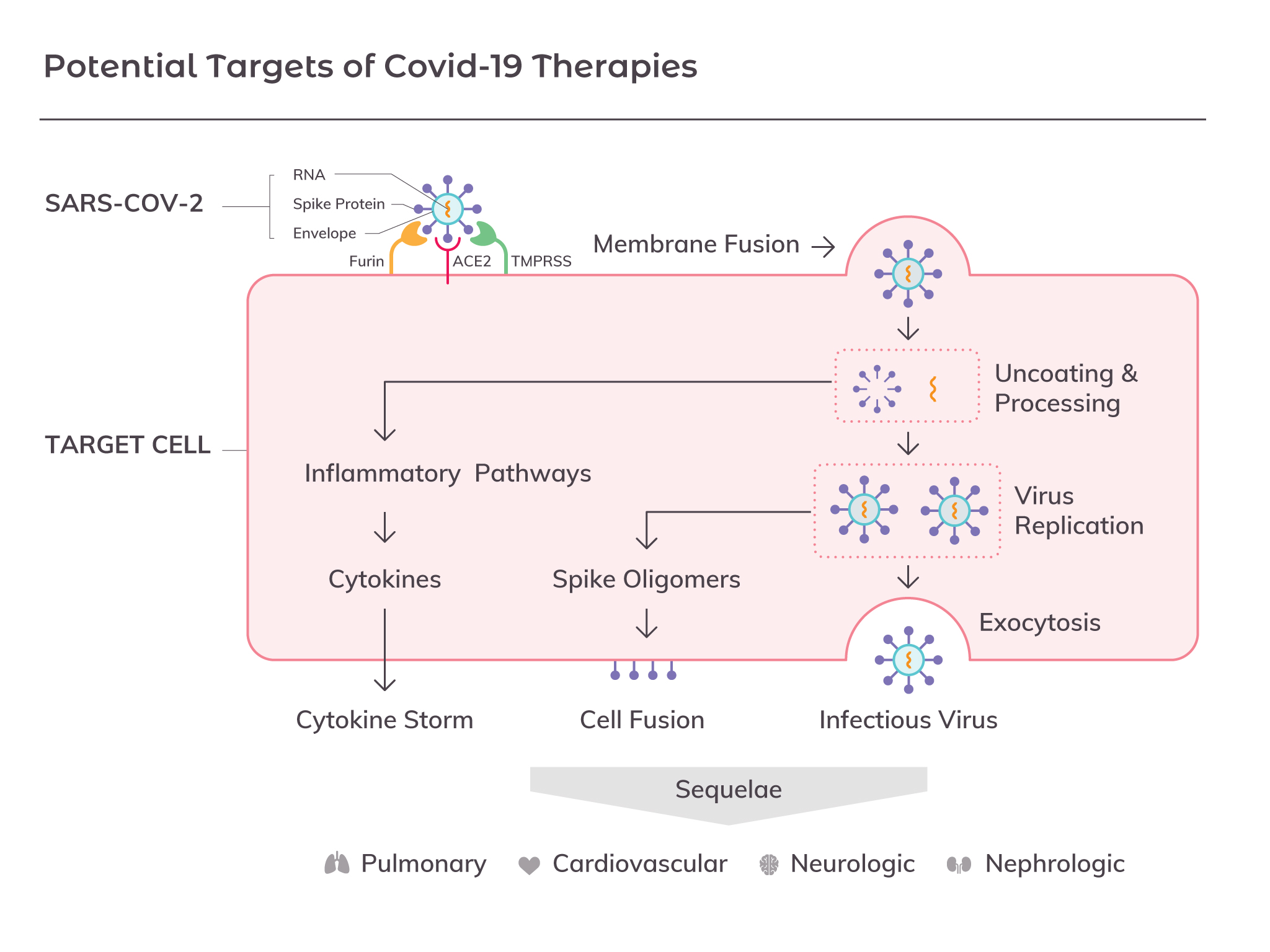4 min read
COVID-19 Targets, Tools and Therapeutics (Part 1)
Antibody Solutions is doing its part to respond to the COVID-19 pandemic, including original research, tool discovery, and participation in in-house and client-sponsored discovery programs. In this new blog series, we examine questions such as: What are the potential targets to treat COVID-19 and its sequelae, and what are the strategies and tools to discover drugs to treat the disease?In Part 1 of this series, we describe the causes of COVID-19 and potential disease targets. In Part 2, we will describe some of the tools that can be used to validate the targets and discover potential therapeutics. Finally, in Part 3, we will describe some of the strategies for therapeutic intervention of those targets.
While caused by infection of the respiratory tract with a single virus, SARS-CoV-2, COVID-19 can result in a myriad of outcomes. The severity of the disease can range from mild symptoms to severe respiratory tract illness to serious medical conditions affecting diverse organs concurrently. Understanding the various disease mechanisms at play and the different responses of infected individuals is key to determining how the disease can be effectively treated. The complexity of outcomes from infection will likely require different therapies tailored to each manifestation of the disease.
Anatomy at-a-Glance: Inside the SARS-CoV-2 Virus
SARS-CoV-2 is an enveloped RNA virus whose key feature is a spike protein on its surface that mediates viral infectivity.
Infectivity appears to be determined by three regions on the spike protein: a receptor binding domain (RBD), and two cleavage domains acted on by the host proteases, furin and TMPRSS2. The RBD of the spike protein binds to the angiotensin-converting enzyme 2 (ACE2) that is highly expressed in cells of the lower respiratory tract such as Type II alveolar cells (AT2) of the lungs, upper esophagus and stratified epithelial cells. ACE2 is found on other cells, including absorptive enterocytes from the ileum and colon, cholangiocytes, myocardial cells, kidney proximal tubule cells, and bladder urothelial cells. Infection with the virus then can lead not only to respiratory problems such as pneumonia and Acute Respiratory Distress Syndrome (ARDS), but also disorders of the heart, kidney, and digestive tract. Cleavage of the spike protein by the host cell proteases furin and TMPRSS2 arm the virus for fusion with host cell membranes.
Each of the three regions of the spike protein (i.e., RBD, Furin, and TMPRSS) are potential sites of therapeutic intervention to block virus infection.

SARS-CoV-2 in Action
Once inside the cell, uncoating and processing of the virus releases virus RNA that is translated by the host cell to produce viral proteins. Fully assembled virus is then released to infect adjacent cells. Spike protein that does not get assembled into virions may appear on the cell surface and mediate cell–cell fusion between infected cells and adjacent, uninfected cells.
Virus replication can trigger the production of pro-inflammatory cytokines and chemokines by the host cell in response to the virus. Secretion of these cytokines and chemokines attracts immune cells, notably monocytes and T lymphocytes, from the blood into the infected site. The recruited cells can further trigger a “cytokine storm” that mediates widespread lung inflammation and may have additional systemic effects such as septic shock and multi-organ failure. That said, targeting the host and immune cell responses to the virus may be as important as targeting the mechanism of infection by the virus itself.
The Potential Downstream Consequences of SARS-CoV-2 Infections
COVID-19 may lead to other medical conditions as a consequence of the initial disease (e.g., sequelae), which can be exacerbated by another disorder (e.g., co-morbidities).
The main sequelae of patients with severe forms of COVID-19 is the development of pulmonary fibrosis. These patients may also present significant cardiovascular complications, including infection-related myocarditis, arrhythmias, and deep vein thrombosis. Kidney and liver functions may be impaired or damaged as a consequence of direct infection by the virus or effects of the cytokine storm. A systemic hyper-inflammatory response may cause long-term cognitive decline, such as deficiencies in memory, attention, processing speed, and functioning, along with diffuse neuronal loss. Other inflammatory complications and autoimmune manifestations have been described such as Guillain-Barré syndrome and, in children, an inflammatory syndrome with clinical features similar Kawasaki disease. The implications of all that suggest that treating the sequalae of COVID-19 will likely require targeting of organ-specific diseases.
While the primary therapeutic focus has been on blocking virus infection and treating the acute phase of COVID-19, it is increasingly clear that many patients who have recovered may need continuing treatment for long-term effects. Recovery may be slow, incomplete, and costly, with a huge impact on quality of life. The multitude of patient responses to SARS-CoV-2 infection, manifestations of COVID-19, and its sequalae will require a diverse set of interventions targeting the virus, the host response to the virus, and the organ-specific medical conditions that arise.
Receive our latest news & insights right in your Inbox.
Subscribe to our email list if you would like to receive notifications from Antibody Solutions, including the release of Part 2 of this series "COVID-19 Targets, Tools and Therapeutics" where we will describe the some of the Tools that can be used to validate the targets and discover potential therapeutics. If you have any questions, please contact us.

Author of more than 40 publications, John’s current research interests include new technologies for improving therapeutic antibody discovery, properties of next-generation antibody-like molecules, and best practices for critical reagents used in biologics development.




